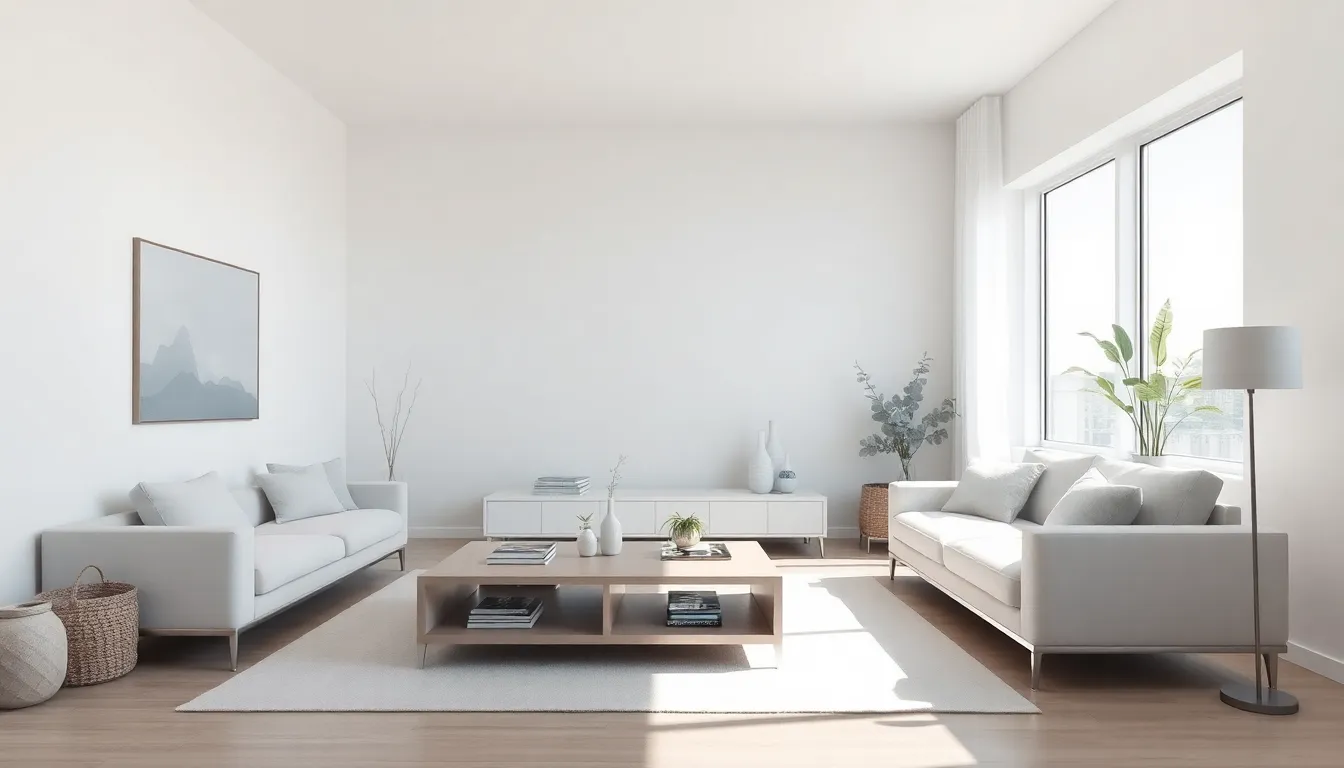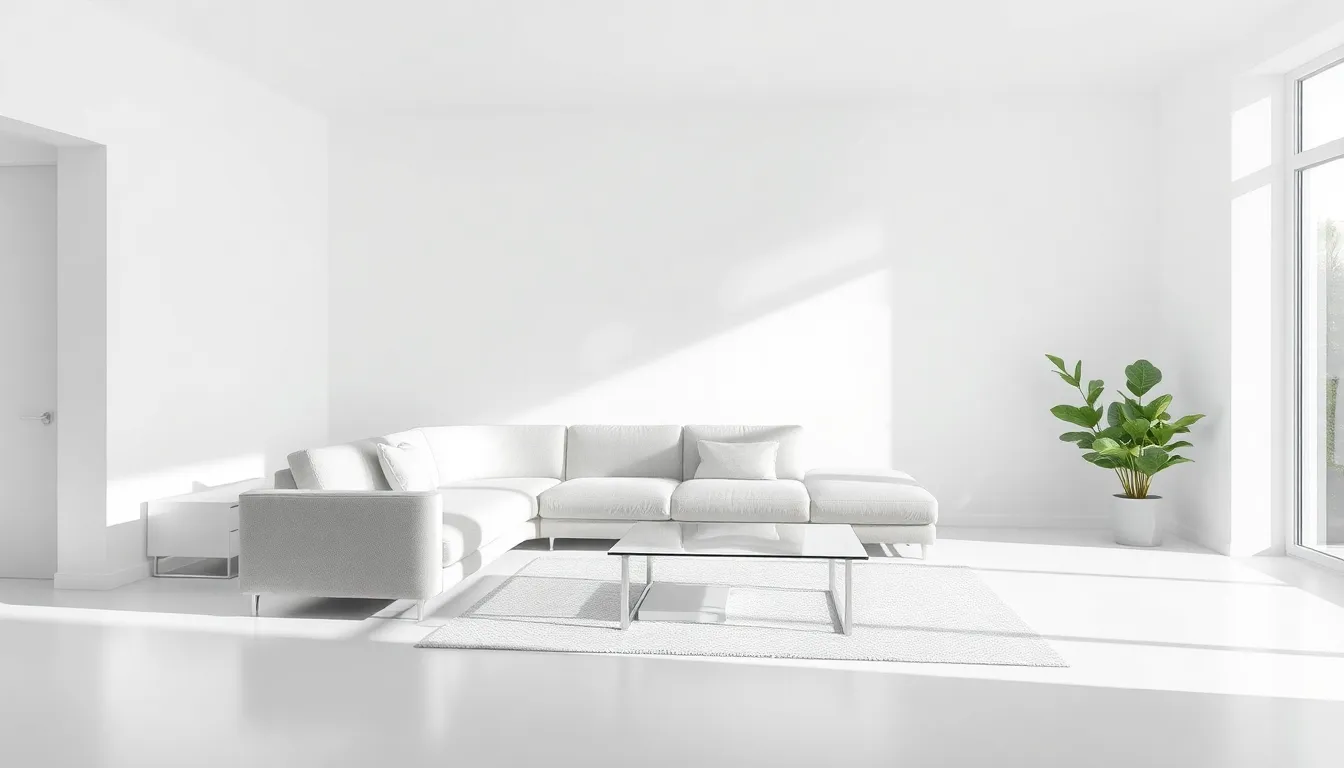In a world filled with clutter and chaos, the minimalist living room design emerges as a breath of fresh air. Imagine stepping into a space where less truly means more. No more dodging furniture like it’s an obstacle course or searching for that one elusive remote buried under a mountain of throw pillows. Minimalism invites simplicity and serenity, transforming your living room into a stylish sanctuary.
Picture sleek lines, neutral palettes, and just the right amount of decor to keep things interesting. It’s not just about aesthetics; it’s about creating a space that sparks joy and promotes relaxation. With minimalist design, you can finally say goodbye to the overwhelming clutter and hello to a room that reflects your personality without the baggage. So grab a cup of coffee, kick back, and explore how minimalist living room design can elevate your space and your mood.
Table of Contents
ToggleWhat Is Minimalist Living Room Design?
Minimalist living room design embodies simplicity and functionality. This approach focuses on reducing clutter while maximizing visual appeal. Often, it features clean lines and open spaces that promote a sense of tranquility. Neutral color palettes dominate, creating a calming atmosphere that encourages relaxation.
Furniture plays a critical role in this design style. Each piece is thoughtfully selected, emphasizing quality over quantity. Items like sleek sofas and streamlined coffee tables enhance the overall aesthetic without overwhelming the space. Accessories are kept to a minimum, serving only to complement the overall theme.
Lighting also contributes significantly to minimalist designs. Natural light is favored, with large windows or unobtrusive window treatments ensuring an airy feel. Artificial lighting consists of simple fixtures that provide necessary illumination without detracting from the streamlined look.
Textures and materials provide depth in minimalist settings. Wood, metal, and glass are commonly used, blending seamlessly to create a cohesive environment. Incorporating soft textiles, like cushions or throws, adds warmth while maintaining the uncluttered integrity of the design.
This living room style reflects a lifestyle choice that values peace and intentionality. By eliminating excess, individuals find joy in their surroundings and create spaces that foster creativity and relaxation. Minimalist living room design encourages personal expression while inviting calmness into everyday life.
Key Principles of Minimalist Design

Minimalist design focuses on achieving an aesthetic that promotes peace and simplicity. It emphasizes the elegance of simplicity in both form and function.
Simplicity and Functionality
Simplicity defines minimalist design, ensuring each element serves a clear purpose. Functionality takes precedence, allowing for seamless movement and interaction within the space. Furniture choices reflect this principle, with sleek designs that prioritize utility over ornamentation. Every piece contributes to the overall harmony, creating an inviting atmosphere. Minimal decor items enhance rather than distract from the essential pieces. Selecting furniture with integrated storage solutions resolves clutter while maintaining a clean environment.
Neutral Color Palettes
Neutral color palettes dominate minimalist living rooms, providing a serene backdrop. Shades of white, beige, gray, and soft pastels create a cohesive look and enhance natural light. Using these colors allows for easy blending of furniture and decor, maximizing visual appeal. Accents in deeper tones can introduce interest without overwhelming the room’s tranquility. Textures emerge as key features, with finishes like matte or gloss complementing the neutral tones. This choice fosters a calming ambiance, ideal for relaxation and contemplation.
Decluttering and Space Optimization
Decluttering remains central to successful minimalist design, as it clears visual distractions. Minimizing belongings ensures that only essential items occupy the space. Thoughtful organization enhances functionality, allowing for fluid movement throughout the room. Space optimization is crucial, as it makes areas feel more expansive and inviting. Utilizing multi-purpose furniture caters to both aesthetics and practicality, promoting use without excess. Emphasizing open spaces leads to a sense of freedom and tranquility within the living room.
Essential Elements of a Minimalist Living Room
Minimalist living rooms prioritize simplicity and functionality while creating calming spaces. Essential elements focus on furniture selection, lighting choices, and decorative accents.
Furniture Selection
Selecting furniture involves choosing pieces that are functional yet stylish. A single statement sofa often serves as a focal point, offering comfort without overwhelming the space. Opting for multi-purpose furniture, like a coffee table with storage, maximizes usability. Sleek lines and low profiles enhance a sense of openness. Important considerations include quality materials which contribute to longevity and aesthetic appeal.
Lighting Choices
Proper lighting significantly influences a minimalist living room’s atmosphere. Natural light from large windows invites the outdoors inside, fostering a connection with nature. Simple pendant lights or floor lamps often complement minimal furnishings, avoiding visual clutter. Warm, soft lighting creates an inviting ambiance while ensuring efficiency. Dimming options provide versatility, adapting the space for various moods and activities.
Decorative Accents
Decorative accents enhance a minimalist living room without creating chaos. Choosing a few artwork pieces adds personality while maintaining a clean look. Textured textiles, such as soft throw pillows or a cozy blanket, introduce warmth and comfort. Plants bring life to spaces, promoting a serene vibe without overwhelming the design. Each chosen accent should serve a clear purpose or theme, reinforcing the overall simplicity and elegance of the environment.
Tips for Creating Your Minimalist Living Room
Creating a minimalist living room requires attention to detail and purposeful choices. Here are effective tips to achieve a serene and stylish environment.
Reducing Clutter
Start by evaluating items in the living room. Eliminating unnecessary pieces enhances openness. Regularly assess belongings to keep only essentials in the space. Utilize storage solutions with hidden compartments to maintain a clean look. Opt for multifunctional furniture that serves dual purposes without adding extra bulk. Keep surfaces clear to promote a sense of calm while showcasing the beauty of simplicity.
Selecting the Right Furniture
Furniture selection plays a critical role in minimalist design. Choose pieces with clean lines and a sleek silhouette to complement the overall aesthetic. Prioritize quality over quantity, focusing on items that provide utility and aesthetic appeal. Look for sofas and chairs that offer comfort without compromising on style. Multi-purpose furniture such as storage ottomans or coffee tables with hidden compartments maximizes space efficiency. Consider neutral tones to help unify the room and maintain a tranquil atmosphere.
Incorporating Natural Elements
Incorporating natural elements elevates the minimalist living room experience. Integrate wood, stone, or metal to add texture and warmth. Selecting plants introduces life and greenery while contributing to the uncluttered look. Use simple planters that align with the minimalist theme to enhance visual appeal without distraction. Large windows allow abundant natural light, creating a bright and inviting ambiance. These details facilitate a connection to nature, promoting relaxation within the space.
Embracing minimalist living room design transforms spaces into serene sanctuaries. This approach prioritizes simplicity and functionality while allowing personal style to shine through. By focusing on essential elements and reducing clutter, individuals can create an inviting atmosphere that promotes relaxation.
The careful selection of furniture and decor enhances both aesthetics and utility. Incorporating natural materials and textures adds warmth without overwhelming the space. Ultimately, minimalist design isn’t just about aesthetics; it’s a lifestyle choice that encourages intentional living and fosters a sense of calm in daily life. Adopting these principles can lead to a more peaceful and enjoyable home environment.



